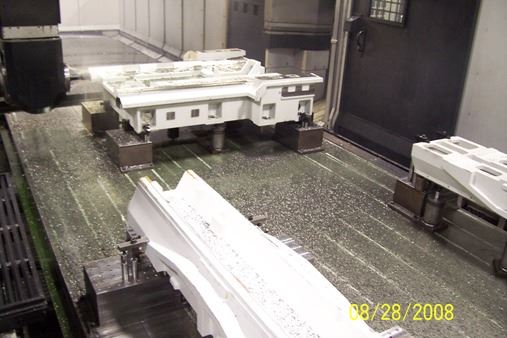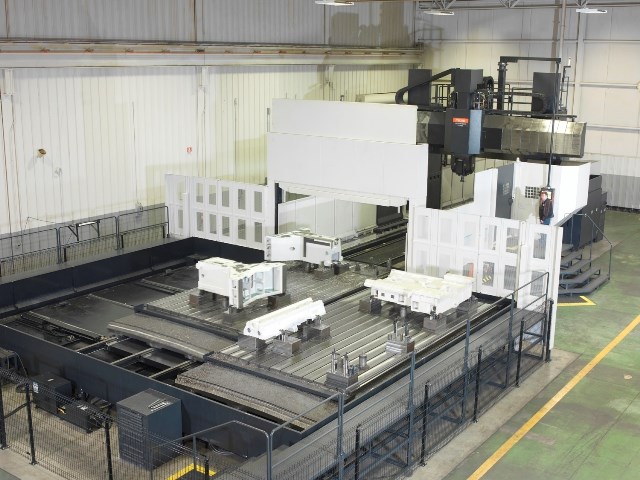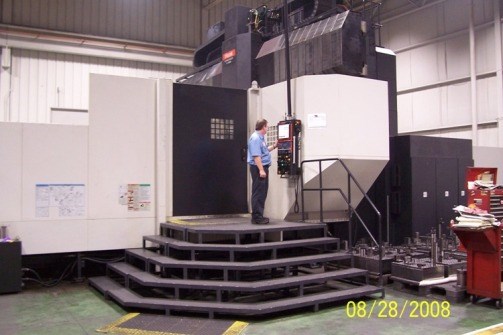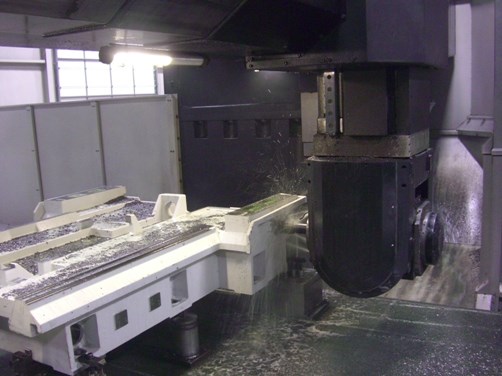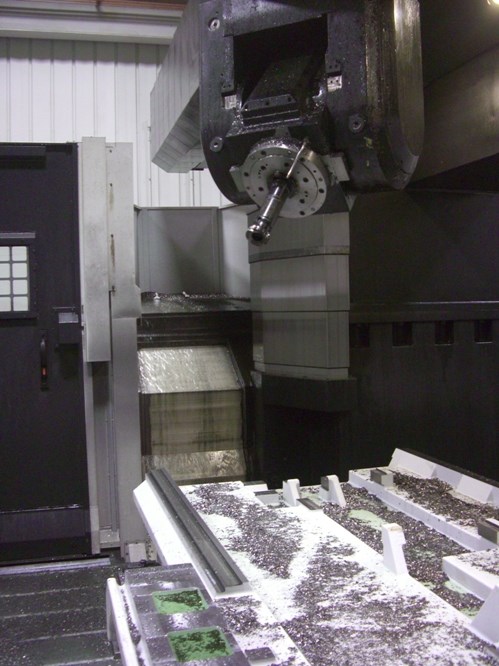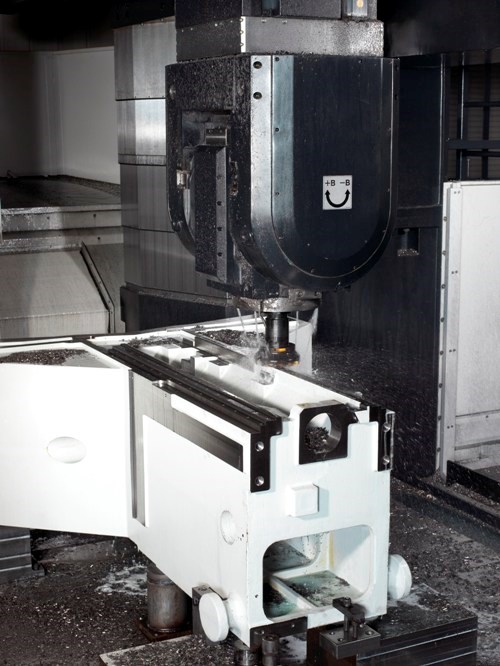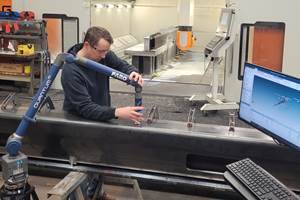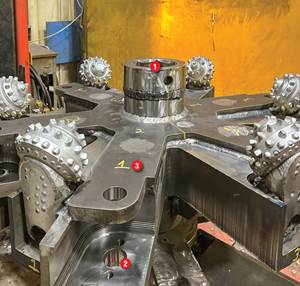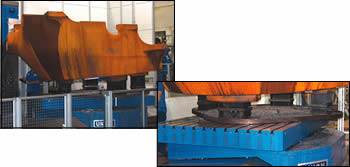The Basics Of Producing Big Parts
This Florence, Kentucky-based machine tool builder uses its own equipment to produce machine tools. Here’s how they succeed at big-part machining on a large five-axis machining center.
Share





Lately, opportunities for growth in the American manufacturing market have shifted away from the smaller, commodity sized parts that everyone can make to parts that are too large, too small or too challenging for most shops to produce. Pursuing the big-part opportunities has prompted manufacturers to buy bigger machines to increase the size of the parts they can process.
Machine tool supplier Mazak recently introduced one such big machine—the new V140N machining center. The company installed this machine in its own Florence, Kentucky, facility.
Seeing how this machine is used there, and speaking with some of the machine tool builder’s personnel who are involved with the machine, revealed some important considerations for using a large machine tool effectively.
Covering the Basics
It almost goes without saying that some basic things are essential to successful machining, regardless of part size. For example, tools typically should be stored, built, and maintained in the tool room and presented to the machine when the setup is complete. Some shops use setup carts for this task, but the ideal tool-chain should be large enough to carry all the tools necessary to run all the parts needed to maintain one-piece flow. Having enough room in the tool chain to carry spare tooling for operations that require it is an added bonus. Tool-life management can help manufacturers utilize spare tooling effectively and maintain process control from part to part.
Fixtures and parts should be stored close by the machine for easy access. Some shops have an FMS system (or a similar system for storage and retrieval), while others use a more manual system. With careful planning, the manual system can be nearly as effective in reducing setup time as an automatic system.
These things are true independent of part size. But for large part machining, some things are different. And to be successful, shops have to develop techniques for doing these things well.
Now the Big Stuff
One thing that is different is obviously the size of the parts. When a part weighs as much as a small car, great care must be exercised in its storage, loading and unloading on and off the machine. When working with smaller parts, safety shoes or other personal protective equipment (PPE) might be sufficient to protect operators should a part accidentally fall. But with larger parts, PPE offers little resistance and drops can be lethal.
The equipment used to load large parts requires more training to use properly. The use of overhead lifting devices such as cranes and hoists requires that operators be aware of their own presence and the presence of co-workers and other traffic in the area. Inspection and maintenance of the lifting equipment must be performed in accordance with all applicable regulations and ordinances. Even storage of the tools required to load the parts requires some thought. Mazak utilizes a system of overhead cranes to safely move large base castings to and from the V140N.
When working with very large parts, some tools will need to be loaded manually because of either excessive weight or excessive size. Automatic tool changer designs accommodate a maximum length, weight and diameter. Tools that fall outside of that range will need to be loaded manually.
Safe manual loading of tools requires that the table be parked in a safe location and the machine interlocked in such a way to prevent unwanted machine motion during the tool change. For some controls, the interlocking can be a little tricky because turning off the power to drives (to prevent motion) sometimes creates control faults that can cause position information to be lost. With a properly interlocked machine an operator can safely enter the work zone, change the tools, exit and continue in the program without lost machine time. Operators should also pay extra attention when loading machine offsets and other programming during manual tool changes.
Extra care is also required when positioning parts in the fixtures on the machine. Some companies spend a great deal of time at a large surface plate “laying out” castings and adding witness lines to which the machinists make qualifying cuts. Mazak uses a probe to perform this function. Once the parts are loaded into the fixture and the program started, the probe checks to see if the casting is against the primary locators. If the locators are against the fixture properly, the datum structure for all subsequent machining can be established. If the casting is not properly located, the operator is alerted. In the same way, probing the casting can help center-up stock and make alignment adjustments to account for casting variation. At Mazak, lead programmer Jeff Bay works continuously to perfect probing routines that allow the machines to run more automatically.
Offline programming is more efficient than programming at the machine for optimizing tool paths and minimizing tool changes. Due to its size, even a very fast large-part machine can take a lot of time to travel long distances. Any unnecessary motion will add wasted cycle time. Keeping programs backed up via DNC is also a critical step in efficient operation. It is not only a regulatory requirement in some settings to only keep one copy of the program (whether it be in machine memory or on the server) it is also efficient to regularly upload the program to the server making sure edits are kept and any related documentation is updated. Mazak keeps critical machines at its Florence, Kentucky facility tied to its Cyberfactory system to maintain programs that the machines run. This system can even schedule the machine’s next part, which is crucial to saving time between parts.
Five-Axis Time Savers
Some other ways that Mazak saves time in the cut is to machine all the parts that require a particular tool while that tool is in the spindle. Even though the V140N changes tools in about two seconds, the time necessary to move from the cut to the tool change position and back can add up.
After cutting a critical part feature, Mazak can use the probe to determine whether the feature is in print. If the feature needs an extra finish pass, the tool can be reloaded and the pass can be made.
The use of combination tools such as drills that double as thread mills and insert drills that create chamfers around the hole while drilling can be useful when keeping tool change time to a minimum is a concern. Other combinations drill and ream or drill and tap simultaneously. Another variation on the combination tool technology is the use of cutters that can rough and finish at the same time.
Five-Axis Cycle Time Reductions
Since the installation of the V140N in its Florence, Kentucky manufacturing facility, the company has seen cycle time reduced by 50 to 65 percent for parts run on this machine. Part of the difference results from replacing five-face with five-axis machining. Because the machine’s five-axis oscillating head can reach lower to the table than its predecessor, extra machining is combined in a single step. Eliminating extra machining after the fact has improved flow and throughput by 40 to 50 percent. The company can run more parts in a single shift, freeing some much-needed capacity and reducing overtime.
One-Piece Flow
Of all the benefits, perhaps the most valuable has been supporting the company’s long-term goal of implementing one-piece flow on its machining centers. Previously, the batch process left some pieces at operation 10, some at operation 20 and so on, all waiting to be completed. This consumed a great deal of floor space and caused excess handling. The V140N’s five-axis capability reduced the number of milling operations from three to two. Efficient use of the table allowed the company to run both operations simultaneously, completing one set of parts per machine cycle. The machine table also has enough extra space to include a headstock, a saddle, a tailstock, and a cross-slide casting in the same setup. Every time the machine finishes a cycle, all the castings necessary to build a Nexus are completed. The result is a reduction the floor space required to store the in-process castings, not to mention significant reductions in lead-time between machining and assembly.
Related Content
How a Custom ERP System Drives Automation in Large-Format Machining
Part of Major Tool’s 52,000 square-foot building expansion includes the installation of this new Waldrich Coburg Taurus 30 vertical machining center.
Read MoreESOP Solidifies Culture of Continuous Improvement
Astro Machine Works’ ESOP rewards all employees when the shop does well, inspiring many toward continuous improvement as Astro expands its capabilities.
Read MoreThe Cut Scene: The Finer Details of Large-Format Machining
Small details and features can have an outsized impact on large parts, such as Barbco’s collapsible utility drill head.
Read MoreInside a CNC-Machined Gothic Monastery in Wyoming
An inside look into the Carmelite Monks of Wyoming, who are combining centuries-old Gothic architectural principles with modern CNC machining to build a monastery in the mountains of Wyoming.
Read MoreRead Next
More Than Big Machines
This shop specializes in very large components such as rotor hubs and support bases for wind turbines. Its lineup of large horizontal boring mills can handle parts weighing 40,000 pounds and 12 feet on a side. However, the shop’s success also lies in other manufacturing resources and strategies. These include material handling equipment, customized tooling, special fixtures and wireless, portable measuring systems.
Read More5 Rules of Thumb for Buying CNC Machine Tools
Use these tips to carefully plan your machine tool purchases and to avoid regretting your decision later.
Read MoreRegistration Now Open for the Precision Machining Technology Show (PMTS) 2025
The precision machining industry’s premier event returns to Cleveland, OH, April 1-3.
Read More
